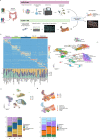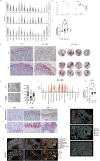Macrophage and neutrophil heterogeneity at single-cell spatial resolution in human inflammatory bowel disease
- PMID: 37495570
- PMCID: PMC10372067
- DOI: 10.1038/s41467-023-40156-6
Macrophage and neutrophil heterogeneity at single-cell spatial resolution in human inflammatory bowel disease
Erratum in
-
Author Correction: Macrophage and neutrophil heterogeneity at single-cell spatial resolution in human inflammatory bowel disease.Nat Commun. 2024 Jan 29;15(1):857. doi: 10.1038/s41467-024-45212-3. Nat Commun. 2024. PMID: 38287036 Free PMC article. No abstract available.
Abstract
Ulcerative colitis and Crohn's disease are chronic inflammatory intestinal diseases with perplexing heterogeneity in disease manifestation and response to treatment. While the molecular basis for this heterogeneity remains uncharacterized, single-cell technologies allow us to explore the transcriptional states within tissues at an unprecedented resolution which could further understanding of these complex diseases. Here, we apply single-cell RNA-sequencing to human inflamed intestine and show that the largest differences among patients are present within the myeloid compartment including macrophages and neutrophils. Using spatial transcriptomics in human tissue at single-cell resolution (CosMx Spatial Molecular Imaging) we spatially localize each of the macrophage and neutrophil subsets identified by single-cell RNA-sequencing and unravel further macrophage diversity based on their tissue localization. Finally, single-cell RNA-sequencing combined with single-cell spatial analysis reveals a strong communication network involving macrophages and inflammatory fibroblasts. Our data sheds light on the cellular complexity of these diseases and points towards the myeloid and stromal compartments as important cellular subsets for understanding patient-to-patient heterogeneity.
© 2023. The Author(s).
Conflict of interest statement
H.H. is co-founder of Omniscope, a scientific advisory board member of MiRXES and consultant to Moderna. A.S. is the recipient of research grants from Roche-Genentech, Abbvie, GSK, Scipher Medicine, Pfizer, Alimentiv, Inc, Boehringer Ingelheim and Agomab; receives consulting fees from Genentech, GSK, Pfizer, HotSpot Therapeutics, Alimentiv, Origo Biopharma, Deep Track Capital, Great Point Partners and Boxer Capital; and is on the advisory boards of BioMAdvanced Diagnostics, Goodgut and Orikine. MaE. has received support for conference attendance and research support from Abbvie, Biogen, Faes Farma, Ferring, Jannsen, MSD, Pfizer, Takeda, and Tillotts. J.P. received financial support for research from AbbVie and Pfizer; consultancy fees/honorarium from AbbVie, Arena, Athos, Atomwise, Boehringer Ingelheim, Celgene, Celltrion, Ferring, Galapagos, Genentech/Roche, GlaxoSmithKline, Janssen, Mirum, Morphic, Nestlé, Origo, Pandion, Pfizer, Progenity, Protagonist, Revolo, Robarts, Takeda, Theravance and Wasserman; reports payment for lectures including service on speaker bureau from Abbott, Ferring, Janssen, Pfizer and Takeda; and reports payment for development of educational presentations from Abbott, Janssen, Pfizer Roche and Takeda. A.M-C has received financial support for conference attendance, educational activities, and research support from Abbvie, Biogen, Ferring, Jannsen, MSD, Takeda, Dr. Falk Pharma and Tillotts. E.K., Y.K., and M.L. are current/former employees and shareholders of NanoString Technologies. S.V. is a current employee of Boehringer-Ingelheim Pharmaceuticals. The remaining authors declare no competing interests.
Figures






References
-
- Verstockt B, Bressler B, Martinez-Lozano H, McGovern D, Silverberg MS. Time to Revisit Disease Classification in Inflammatory Bowel Disease: Is the Current Classification of Inflammatory Bowel Disease Good Enough for Optimal Clinical Management? Gastroenterology. 2022;162:1370–1382. doi: 10.1053/j.gastro.2021.12.246. - DOI - PubMed
Publication types
MeSH terms
Substances
LinkOut - more resources
Full Text Sources
Medical
Molecular Biology Databases

